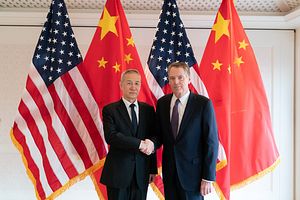Trans-Pacific View author Mercy Kuo regularly engages subject-matter experts, policy practitioners, and strategic thinkers across the globe for their diverse insights into U.S. Asia policy. This conversation with James Green – the creator and host of Georgetown University’s U.S.-China Dialogue Podcast, a Senior Advisor at McLarty Associates, and former Minister Counselor for Trade Affairs at the U.S. Embassy in Beijing (2013-2018) – is the 187th in ”The Trans-Pacific View Insight Series.”
What key factors contributed to the breakdown in U.S.-China trade talks?
Well, I’m not certain we’re quite at the point of breakdown. Clearly when Chinese Vice Premier Liu He visited Washington May 9-10, there was not a breakthrough in the trade negotiations in terms of inking an agreement, but the two sides are still talking despite the U.S. move to increase tariffs on $200 billion in Chinese exports from 10 percent to 25 percent. Every trade negotiation has an ebb and flow, a rhythm, a back-and-forth like a well-choreographed Peking Opera. And my sense is the Chinese side misjudged where the negotiations were at the beginning of May. The positive talk of reaching an agreement by the time of Liu He’s recent visit may have given Beijing officials overconfidence that some items which the U.S. thought closed were open to further reinterpretation. There is also the real possibility that incomplete coordination within the Chinese government — between ministries and then with parts of the senior leadership — led to a mishandling of United States Trade Representative (USTR) Robert Lighthizer and Treasury Secretary Steven Mnuchin’s late April negotiation round in Beijing. At the core, efforts to liberalize the Chinese economy to benefit U.S. companies and Chinese consumers have encountered orchestrated opposition from vested interests, which do not see a need to change aspects of Chinese state capitalism.
Explain the near- and long-term impact of the U.S. tariff hike to 25 percent on American consumers and industries.
The $200 billion worth of products that will be under 25 percent tariffs as of around June 1 were already subject to a 10 percent tariffs under the earlier finding of the Section 301 investigation that Chinese forced technology transfer policies harm U.S. commercial interests. Many of those items are industrial and light-manufactured products that are used as inputs for U.S. factories, builders, and service companies. The tariffs are a tax paid at the port of entry by the U.S. importer to U.S. Customs. So that 15 percentage point difference may be reflected in higher prices for U.S. businesses and end-users of those goods, or lower profits for Chinese exporters. For consumers, a much larger impact will be felt if additional tariffs are placed on the remaining roughly $350 billion of Chinese exports to the U.S.; USTR is reportedly beginning the required notice-and-comment period for those proposed new tariffs on new products.
Analyze the risk calculus behind China’s retaliation.
To date, the Chinese Ministry of Commerce has publicly taken a calibrated approach to the latest round of U.S. tariff increases, stating that China would take “necessary countermeasures” on May 9. On May 13, the Chinese Ministry of Finance explained that as of June 1, $60 billion of U.S. imports would be subject to tariffs of 20 or 25 percent ̶ up from a 10 percent tariff level from previous rounds of tit-for-tat tariffs. Chinese officials are looking to signal resolve against the increased U.S. tariffs and to harm certain sectors of the U.S. economy that might bring the U.S. administration to conclude a trade agreement ̶ yet the trade imbalance in China’s favor makes a dollar-for-dollar retaliation impossible. Chinese officials may slow approvals of licenses for U.S. companies or to import certain agricultural goods, but at this stage are unlikely to advocate for a general boycott of U.S. products or companies. The Chinese government still seeks foreign investment, particularly in new technology.
What is at stake for Presidents Trump and Xi in terms of effective leadership?
Communist Party General Secretary and PRC President Xi Jinping was not elected to office, but every Chinese leader since Deng Xiaoping has been evaluated internally, in part, by properly managing the bilateral relationship with the United States. For President Xi, at a moment when he is leading China’s increasingly muscular foreign policy and tightening of political space at home, having a good relationship with the United States is a key tool for his other foreign and domestic goals. President Donald Trump has lauded his personal relationship with President Xi while at the same time pushing for a tougher approach to perceived imbalances in the bilateral trading relationship.
Assess whether U.S.-China strategic rivalry will intensify and the policy implications for U.S. companies.
Buckle up, because there will be turbulence ahead for the U.S.-China relationship. General Secretary Xi Jinping’s January 2017 Davos speech that China has a model for other nations to emulate and the U.S. National Security Strategy in December 2017 ̶ boldly stating that “China and Russia challenge American power, influence, and interests, attempting to erode American security and prosperity” ̶ set the stage for friction in the military, cyber, technology, human resources, trade, and security domains. Companies will have to adjust ̶ by diversifying supply chains, closely watching tighter regulations on U.S. export controls and on Chinese investment, and ensuring the right footprint in China to prepare for certain sectors that may liberalize as a result of any trade agreement. All that said, wise statesmen and women from both countries will continue to search for areas of overlapping interests and will advance policies to improve the lives of Americans, Chinese, and citizens around the world.

































